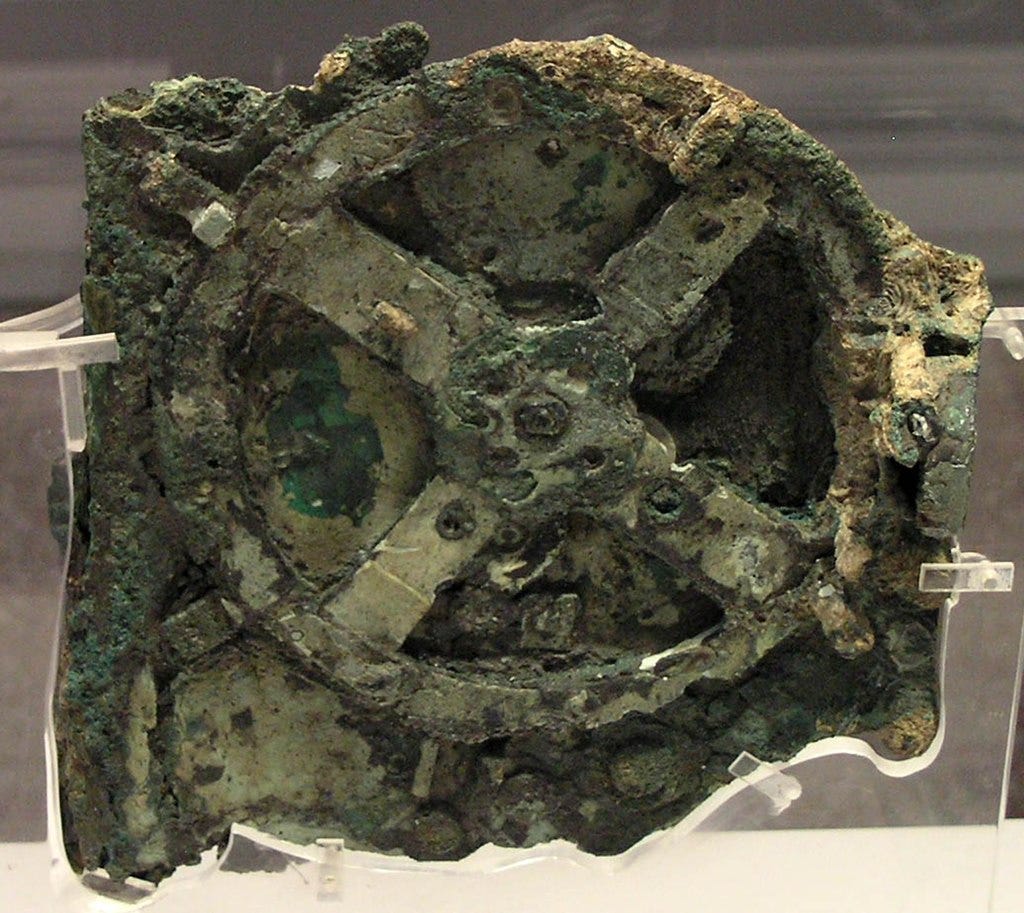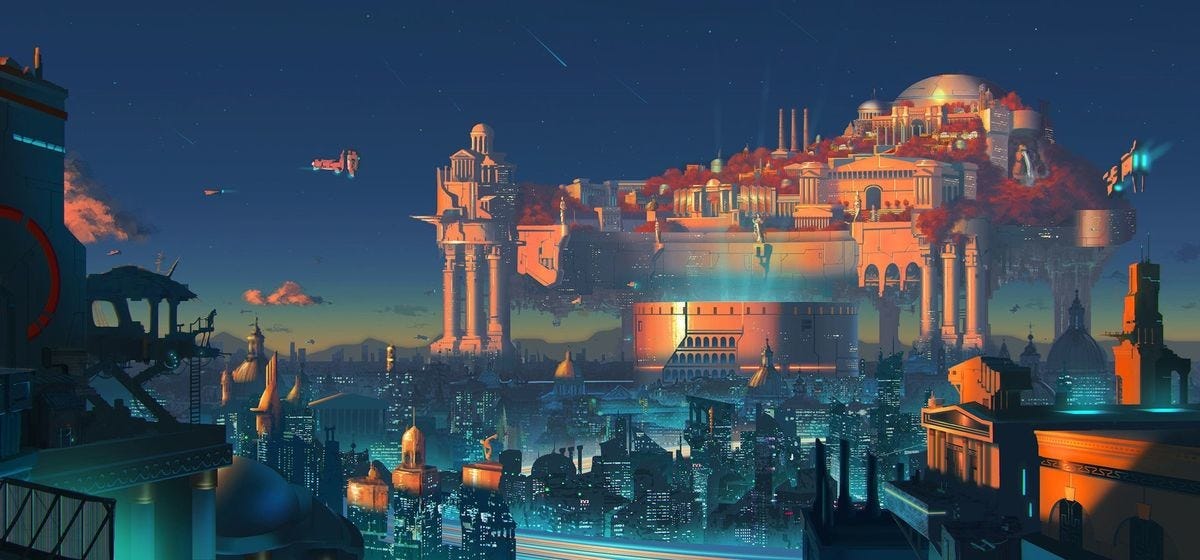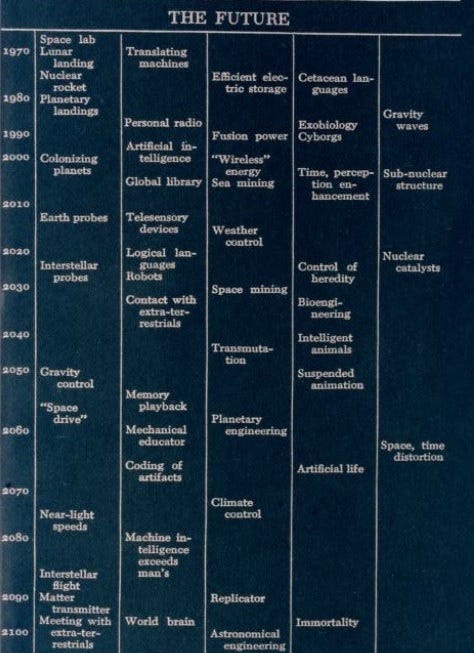🤔 What if the Industrial Revolution had started 2,000 years ago rather than 200? (And why didn't it?)
Also: Five Quick Questions for . . . Jason Crawford, creating a philosophy of progress
“In every society, there are stabilizing Forces that protect the status quo. Some of these forces protect entrenched vested interests that might incur losses if innovations were introduced, others are simply don't-rock-the-boat kinds of forces. Technological creativity needs to overcome these forces.” - Joel Mokyr, The Lever of Riches: Technological Creativity and Economic Progress
In This Issue
Long read: What if the Industrial Revolution had started 2,000 years ago rather than 200? (And why didn’t it?)
5QQ: Five Quick Questions for . . . Jason Crawford, creating a philosophy of progress
Micro Reads: Xenotransplantation, nuclear waste, Tesla, and more . . .
🤔 What if the Industrial Revolution had started 2,000 years ago rather than 200?
The previous Faster, Please! Long Read essay, “The Smithsonian’s dreary 'Futures' exhibition is stuck in the eco-pessimist 1970s” — my highest-traffic piece so far — recounts my disappointment with the national museum’s inept attempt to show an optimistic and inspiring future. During my recent visit, I went in expecting to see displays about reusable rockets, CRISPR, nuclear fusion, and the future of mRNA vaccines. Instead, I got displays about wastewater recycling, biodegradable mushroom bricks, and 1960s agricultural activist Cesar Chavez. The whole effort suffered from a profound lack of imagination — plus, suspiciously, a lack of any mention of Elon Musk — about a possible future built creating abundance rather than merely managing scarcity. It didn’t even qualify as good solarpunk.
After I left “Futures,” I started thinking about the Antikythera Mechanism. It’s an ancient astronomical calculating machine of such complexity that some have called it the first computer. The device, probably built around 140–100 B.C., could predict solar eclipses and organize the calendar into the four-year cycles of the Olympiad, forerunner of the modern Olympic Games. Sponge divers retrieved it in 1901 from a sunken Roman cargo ship off the coast of the Greek island of Antikythera. Modern researchers, using high-resolution imaging systems, continue to learn more and more about exactly how it worked and all it could do. In the new Scientific American article “An Ancient Greek Astronomical Calculation Machine Reveals New Secrets,” Tony Freeth of the University College London Antikythera Research Team explains the group’s latest findings about how exactly this two-millennium-old bit of technology worked. Freeth concludes:
It was not until the 14th century that scientists created the first sophisticated astronomical clocks. The Antikythera mechanism, with its precision gears bearing teeth about a millimeter long, is completely unlike anything else from the ancient world. . . . As for why the technology was seemingly lost for so long before being redeveloped, who knows? There are many gaps in the historical record, and future discoveries may well surprise us.
All of which suggests an intriguing counterfactual: What if the Antikythera Mechanism and the technological sophistication that built it had not disappeared from the pages of history for 1500 years? Why not a Scientific Revolution leading to a Industrial Revolution in Ancient Greece? Indeed, science historian Derek Price, one of the early analysts of the Antikythera Mechanism, urged his fellow scholars to “completely rethink our attitudes toward ancient Greek technology. Men who could have built this could have built almost any mechanical device they wanted to.” Freeth describes the Greeks as “highly capable — they built the Parthenon and the Lighthouse of Alexandria even earlier than the Antikythera mechanism. They had plumbing and used steam to operate equipment.” (Yes, I am of Greek descent. Why do you ask?)
In Kingdom of the Wicked, Helen Dale imagines an alt-history Roman Empire of cable news and airplanes — albeit one about to be greatly unsettled by a certain young, charismatic Jewish religious zealot from Palestine. How did Dale’s Roman Empire accelerate? Call it the Archimedes Mechanism. Rather than die at the Siege of Syracuse in 212 B.C., the brilliant Greek polymath Archimedes is captured by Roman forces and becomes the equivalent of the German rocket scientists scooped up by the American military after World War II. He invents calculus some 15 centuries before Isaac Newton — something he almost accomplished in our reality — and brought all manner of technical know-how to the Roman military, eventually triggering a wider technological revolution.
Pushing forward that counterfactual, we might today be looking at a world so different as to challenge the imagination of even the most visionary science-fiction writers. (Star Trek, after all, is only supposed to take place a few hundred years from now.) We might have already met and solved some of the biggest challenges we currently face.
Some intriguing, if highly speculative ideas, of what’s next for humanity can be found on the website Future Timeline, the hub of an international futurist community. Among the speculations for the rest of the 21st century: by 2059, the end of the Oil Age and a permanent base on Mars. By 2062, nanofabricators are a mainstream consumer product. By 2080, the first space elevator becomes operational. By 2092, West Antarctica is among the fastest developing regions in the world.
Go further out, and things really get wild. The community sees Mars terraformed by 2500, “turned from a cold, dead world into a lush, Eden-like paradise.” It won’t be easy. Protecting the planet from harsh ultraviolet radiation and creating a magnetosphere might require encircling the planet with underground giant superconducting rings over the course of decades. Venus has its turn in 2700. Nanobots help convert the toxic atmosphere into breathable oxygen while comets redirected from the Oort Cloud and Kuiper Belt bring it vast quantities of water. By 3000, even purely biological humans would typically resemble NBA players — tall, muscular, graceful — with healthy and vigorous lifespans of over 120.
So maybe the curators of “Futures” should have taken a peek at the Future Timeline sight. Another option: Check out the 1967 book, Profiles of the Future, in which author and futurist Arthur C. Clarke helpfully created a timeline of what he thought might happen and when it might happen, seen below. (A caveat from Clarke: “The chart, of course, is not to be taken too seriously.”)
If only that Smithsonian exhibit had displayed something approaching that level of imagination, even if it meant pushing the bounds of science as we currently understand it.
And why didn’t the Industrial Revolution start 2000 years ago? One important reason: Those pre-industrial societies intentionally extinguished the sparks of progress. For millennia, stasis had powerful defenders. The Roman Emperor Tiberius executed rather than rewarded a man who had invented unbreakable glass. Queen Elizabeth I declined to grant a patent to the inventor of the stocking-frame knitting machine, worrying that the invention would deprive textile workers of their employment. The guilds of preindustrial Europe played a key role in making sure Europe stayed preindustrial by blocking new technologies.
Then the protectors of the status quo, like the textile machinery-wrecking Luddites, started to fail. Governments started siding with the innovators and disruptors. Politicians did not like angry workers, but they liked losing wars to richer and technologically superior enemies even less. This is all documented in The Technology Trap by Carl Benedikt Frey, the Oxford Martin Citi Fellow at Oxford University, where he teaches economics and economic history. In November 2019, I had a podcast chat with Frey. From that conversation:
Pethokoukis: What was the original catalyst for the industrial revolution as you understand it?
Frey: So I don’t believe in mono-causal explanations of economic development. I think it was a blend of things that came together that made the industrial revolution, but I think that one very underestimated factor that I highlight in the book has to do with the structure of political power.
Before the industrial revolution, in most pre-industrial societies, craft skills were a source of political clout. They didn’t have any interest in technologies that threatened their jobs and incomes. And, fearing social unrest, monarchs of governments typically sided with the guilds rather than pioneers of industry, fearing that they might challenge the political status quo.
And what happened in Britain was, first of all, with the rise of Atlantic trade, the new merchant class emerged. They were the ones who stood to benefit from mechanization because, with rising wages, mechanization was what allowed them to remain competitive in trade.
Secondly, with the turnpike trusts that paved the way for the construction of much better road networks in Britain, the integration of markets meant that the political power of the craft guilds was gradually eroded because it didn’t extend beyond their own city. And as markets integrated, they were exposed to a lot more outside competition. Cities like Birmingham and Manchester emerged from, essentially, previously rural areas which weren’t exposed to any preexisting crafts guilds, and naturally they also became the masters of the first industrial revolution.
And thirdly, as the political power of the crafts guilds diminished, the threat from below diminished as well. But with growing competition among nation states in Europe, the threat of foreign invasion became much greater, and it therefore became increasingly hard to align technological conservatives with the political status quo.
That is why I think that the first industrial revolution happened in Britain. Science and other things clearly played a very big role as well, but that was in the later stages of the first industrial revolutions and even more so in the second industrial revolution.
As it turns out, Frey is an upcoming subject of Five Quick Questions.
5QQ
⏩ Five Quick Questions for . . . Jason Crawford, creating a philosophy of progress
Jason Crawford is the author of the Roots of Progress blog, where he writes about the history of technology and industry and the philosophy of progress. He is also the creator of Progress Studies for Young Scholars, an online program for high schoolers about the history of technology, and he was formerly a software engineering manager and tech startup founder. In addition, he is working on a book, The Story of Industrial Civilization, and currently hosting a series of monthly talks on the topic.
1/ Why do we need “a new philosophy of progress for the 21st century”?
We need to revive our technological ambition and our sense of agency to build the future. The 19th century had a deep belief in progress, but also some naivete about whether progress was inevitable, and about the risks inherent in technology. Unfortunately, in the 20th century many people became skeptical, distrustful, even fearful of progress. We need a new way forward.
2/ If there is no New Roaring Twenties of faster growth, what probably went wrong?
One or more of three things: First, we failed to reform the bureaucratic and regulatory environment — the skewed incentives that have prevented everything from rapid covid tests to nuclear power. Second, we failed to find better ways of funding research and development. Third, we gave in to fatalism and defeatism (see question 1 above).
3/ What is the most worrisome anti-growth factor out there?
The most worrisome anti-growth factor out there is anti-growth itself. That is, the idea that growth is to be feared and fought. People fear growth in population, in energy usage, sometimes even in GDP. If we decide growth itself is bad, we'll never achieve it, because we'll be actively working against it.
4/ How do we create a more tech-solutionist ethos in our culture? I don't think it's “tech-solutionism” we need exactly, because technology isn't always the main solution to our problems (and is probably never the sole solution). What we need is plain “solutionism”, that is, the belief that problems are solvable — whether that's through technology, policy, ethics, or something else. Solutionism, as I define it, is in contrast to either complacency or defeatism.
5/ What economic view or opinion of yours has been changed/altered by the pandemic?
I've gotten more pessimistic about reforming the bureaucracy. The massive missteps at the FDA, etc. ought to have created an opportunity for reform, but I don't think that's even part of the mainstream discussion — which instead is taken up with partisan arguments about vaccines and lockdowns.
Micro Reads
🐷 In a First, Man Receives a Heart From a Genetically Altered Pig - Roni Caryn Rabin, New York Times | Xenotransplantation for the win. Experts quoted in the piece stress there are many hurdles to overcome before “such a procedure could be broadly applied.” That said, the heart transplant comes “just months after surgeons in New York successfully attached the kidney of a genetically engineered pig to a brain-dead person.” Also a big win for genetic editing:
The heart transplanted into Mr. Bennett came from a genetically altered pig provided by Revivicor, a regenerative medicine company based in Blacksburg, Va. The pig had 10 genetic modifications. Four genes were knocked out, or inactivated, including one that encodes a molecule that causes an aggressive human rejection response. A growth gene was also inactivated to prevent the pig’s heart from continuing to grow after it was implanted, said Dr. Mohiuddin, who, with Dr. Griffith, did much of the research leading up to the transplant. In addition, six human genes were inserted into the genome of the donor pig — modifications designed to make the porcine organs more tolerable to the human immune system.
⚛ Is Nuclear Power Part of the Climate Solution? - Gernot Wagner, WSJ | A handy primer on where the sector stands: “The world can’t afford to dismiss the possibilities of new nuclear technologies, or to prematurely shut down existing nuclear plants that operate safely. Nuclear power comes with risks. So does a warming planet.” The piece also includes a fun fact that relates to the next item: “The U.S. Department of Energy estimates that the nation’s total nuclear waste would cover a single football field, 10 yards high.”
⚛ Why Aren’t We Talking About Nuclear Waste? - Dennis O’Leary, The New Atlantis | For a moment, forget about the “Why can’t American build anymore?” question and focus on the “What can’t America bury” question? The solution is obvious, according to the author, a geologist for the U.S. Geological Survey from 1971 to 2009. “So what to do about this vulnerable, unmentioned infrastructure that hosts our nuclear waste? The answer has always been a national geologic nuclear waste repository.” The science and engineering seem sound. But the politics, of course, remain problematic.
💊 How health care is turning into a consumer product - The Economist | When healthcare consumes nearly a fifth of your economic output, even small changes are a big deal. From the piece:
Clunky, costly, highly regulated health systems, often dominated by rent-seeking middlemen, are being shaken up by companies that target patients directly, meet them where they are — which is increasingly online — and give them more control over how to access care. Scientific advances in fields such as gene sequencing and artificial intelligence (AI) make new modes of care possible. E-pharmacies fulfil prescriptions, wearable devices monitor wearers’ health in real time, tele-medicine platforms connect patients with physicians, and home tests enable self-diagnosis.
🚦 An Equitable Approach to Reducing Traffic Through Congestion Pricing - Stanford University HAI | Congestion pricing is a powerful tool for redirecting traffic to avoid crowded rush-hour roads, but the practice can also heighten inequalities as wealthier drivers take the fast way home while their lower-income counterparts are stuck in traffic. Compensating drivers on slower routes while imposing tolls on drivers taking the fast route could manage urban traffic without exacerbating inequality, but this approach is no easy feat since “each city has its own dynamics, which will be affected by income levels, geography, zoning, and countless other factors.” But, researchers say, artificial intelligence and big data could deliver a win-win system of tolls and refunds that reduces inequality and makes roadways more efficient.
⚡ Goldman Sachs names Tesla a top stock pick for 2022, hikes price target - CNBC | From the GS report:
The company is a Buy-rated OEM in our US coverage that we believe is best-positioned to benefit from broad-based EV market growth in regions including the US, Europe and China given its strong market share, global presence (including new factories it is ramping this year in both Europe and the US) and its leadership position in clean transportation/EVs. Tesla reported robust 4Q21 deliveries. Our 12-month price target of US$1,200 is based on 15X applied to our Q5-Q8 revenue estimate. Key downside risks to our thesis relate to the rate of EV adoption (and the ability for Tesla to meet this demand given supply chain constraints), Model Y demand, increased competition in EVs, the auto cycle, key person risk, the internal control environment, and operational risks associated with Tesla's high degree of vertical integration.






